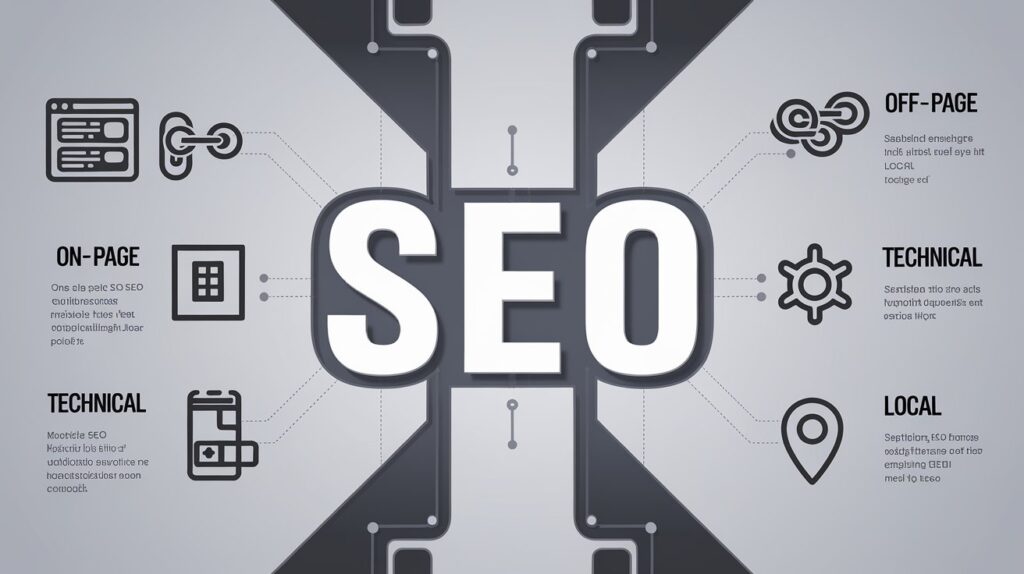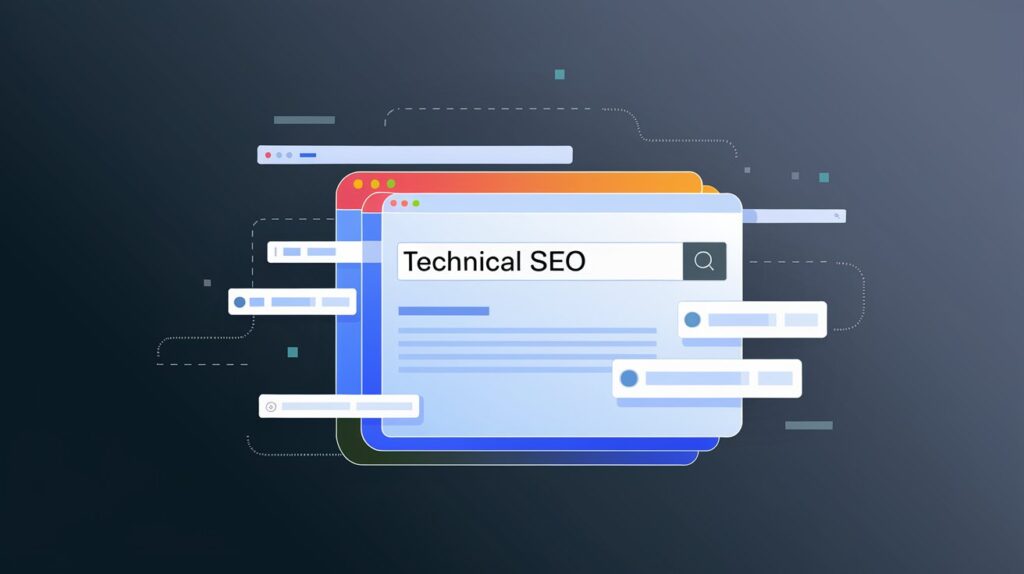SEO ( Search Engine Optimization )

Search Engine Optimization ( SEO ) is the cornerstone of digital marketing. With the rise of online businesses, competition to rank on the first page of search engines is fiercer than ever. Whether you’re a beginner or someone looking to refine your SEO skills, this comprehensive guide will teach you everything about SEO, step by step, from the basics to advanced techniques.
What is SEO?
It’s a process that helps your website rank higher in search engine results pages (SERPs) organically, without paid ads. It’s essential for Digital Marketing, driving targeted traffic to your website, making it visible to potential customers.
Why is SEO Important for Your Website?
Having a great website isn’t enough—people need to find it! It’s improves your visibility, which leads to more traffic, higher conversion rates, and overall business growth. Here’s why It’s matters:
- Increases Organic Traffic – It’s targets quality traffic by making your site more visible on search engines.
- Builds Trust & Credibility – A well-optimized website is seen as reliable by both users and search engines.
- Better User Experience (UX) – Good practices also improve the UX, which keeps visitors engaged longer.
Key Components
1. On-Page SEO
On-page refers to optimizing individual web pages to rank higher and earn more relevant traffic in search engines. This includes:

- Keyword Research: Identifying the terms your audience uses to search.
- Content Optimization: Using keywords naturally in your content to match search intent.
- Title Tags: Crafting catchy and keyword-rich titles.
- Meta Descriptions: Writing concise, engaging descriptions to improve click-through rates (CTR).
- URL Structure: Using clean, keyword-relevant URLs.
- Internal Linking: Linking to other valuable pages on your website.
- Alt Text for Images: Describing images with relevant keywords.
2. Off-Page SEO
Off-page focuses on improving your website’s domain authority through:

- Backlinks: Earning quality links from reputable websites.
- Social Media: Sharing your content on social platforms to gain exposure.
- Guest Blogging: Writing guest posts for authoritative websites in your industry.
3. Technical SEO
Technical involves optimizing your website for search engine crawlers, including:

- Website Speed: Ensuring fast loading times for all pages.
- Mobile-Friendliness: Making your website responsive and accessible on mobile devices.
- XML Sitemaps: Helping search engines find your content.
- Secure Sockets Layer (SSL): Ensuring your website is HTTPS secured.
4. Local SEO
If you run a local business, optimizing for local search is crucial. This involves:
- Google My Business: Creating and optimizing your GMB profile for local search visibility.
- NAP Citations: Ensuring consistency in your Name, Address, and Phone number (NAP) across all platforms.
- Local Keywords: Targeting location-based keywords like “Best digital marketing in Delhi.”
Step-by-Step Guide
Here’s a structured approach :
Step 1: Understand How Search Engines Work
Before diving into Search Engine Optimization strategies, it’s essential to know how search engines like Google, Bing, and Yahoo rank websites. Search engines use crawlers (or bots) to index web pages. Understanding algorithms, ranking factors, and search engine behavior is critical.
Step 2: Master Keyword Research
Keyword research is the foundation of SEO. It involves discovering the search terms your audience uses to find information, products, or services. Tools like Google Keyword Planner, Ubersuggest, and SEMrush can help you identify:
- High-volume keywords: Popular terms users frequently search for.
- Long-tail keywords: Niche keywords with less competition but high conversion potential.
How to do Keyword Research:
- Define your target audience.
- Use keyword tools to find relevant terms.
- Focus on search intent—what users want to achieve when using a keyword.
Step 3: Optimize On-Page SEO Elements
On-page optimization is key to ranking higher on SERPs. Here’s how you can get started:
- Write High-Quality Content: Google values content that is useful, comprehensive, and relevant.
- Use Keywords Naturally: Avoid keyword stuffing but make sure your primary and secondary keywords flow naturally in the content.
- Optimize Meta Tags: Ensure your meta title and description are enticing enough for users to click on.
Step 4: Build High-Quality Backlinks (Off-Page SEO)
Building backlinks from trusted websites is crucial for your domain authority. Here’s how to build them:
- Guest Blogging: Reach out to industry websites and offer to write informative guest posts.
- Content Promotion: Share your content on social media, forums, and with influencers in your niche.
- Broken Link Building: Find broken links on authoritative websites, reach out, and suggest your content as a replacement.
Step 5: Improve Technical SEO
Technical SEO ensures that your website is crawlable and indexable by search engines. Follow these steps:
- Boost Site Speed: Use tools like Google Page Speed Insights to identify areas for improvement.
- Ensure Mobile-Friendliness: Google’s algorithm favors mobile-optimized websites.
- Fix Broken Links: Regularly audit your website for broken links and fix them.
- Implement Structured Data: Add schema markup to help search engines better understand your content.
Step 6: Local SEO
If your business is location-specific, Local SEO will help your audience find you. Here’s what you need to do:
- Claim and optimize your Google My Business listing.
- Use location-specific keywords.
- Encourage satisfied customers to leave positive reviews.
Tools for SEO Success
Several tools can help you on your SEO journey. Here are a few popular ones:
- Google Analytics – Tracks website traffic and user behavior.
- Google Search Console – Monitors indexing status and optimizes site visibility.
- Ahrefs – Assists with backlink analysis and keyword research.
- Yoast SEO – WordPress plugin that optimizes on-page SEO.
- Moz – Provides insights into on-page optimization, keywords, and more.
Advanced SEO Techniques
Once you’ve mastered the basics, you can move on to more advanced techniques like:
- Voice Search Optimization: With more people using voice assistants, optimize for voice search by targeting conversational keywords.
- User Experience (UX) Signals: Focus on user interaction signals like click-through rate (CTR) and bounce rate.
- Core Web Vitals: Prioritize Google’s latest ranking factor, which includes metrics like page loading speed, interactivity, and visual stability.
Conclusion
Mastering it takes time, patience, and consistent effort. By following this guide, you’ll learn everything about Search Engine Optimization —from keyword research to advanced techniques. Remember, SEO is an ongoing process, so keep refining your strategy as search engines evolve. With the right approach, your website can climb the rankings and attract the audience you deserve.
Key Takeaways:
- it involves optimizing your website for search engines to increase organic traffic.
- Focus on both on-page and off-page Search Engine Optimization for maximum visibility.
- Technical SEO and user experience are critical for modern Search Engine Optimization strategies.
- Local SEO is essential for location-based businesses.
Start implementing these steps today to boost your website’s visibility, traffic, and overall success!
Frequently Asked Questions (FAQs)
Q1. How long does SEO take to show results?
It’s a long-term strategy. Typically, it can take 3-6 months to see significant improvements in rankings.
Q2. Can I do SEO by myself?
Absolutely! While hiring professionals can help, you can learn it and start implementing strategies on your own with resources like this guide.
Q3. What’s the difference between SEO and SEM?
Search Engine Optimization focuses on organic search results, while SEM (Search Engine Marketing) involves paid advertising, Such as Google Ads. Both are important for online marketing.
Read More … Click Here
Content By – Branding Ninja


Pingback: The Ultimate Guide to Digital Marketing